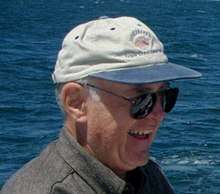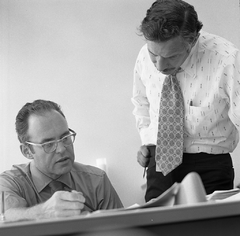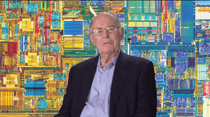Gordon Moore
Gordon Earle Moore (born January 3, 1929) is an American businessman, engineer, and the co-founder and chairman emeritus of Intel Corporation. He is also the author of Moore's law.[3][4][5][6][7] As of October 2019, Moore's net worth is reported to be $11.9 billion.[8]
Gordon Moore | |
|---|---|
 Moore in 2004 | |
| Born | Gordon Earle Moore January 3, 1929 San Francisco, California, U.S. |
| Education | San Jose State College University of California, Berkeley (BS) California Institute of Technology (MS, PhD) |
| Known for | Intel Moore's law Gordon and Betty Moore Foundation |
| Awards | National Medal of Technology (1990) John Fritz Medal (1993) IEEE Founders Medal (1997) Computer History Museum Fellow (1998)[1] Othmer Gold Medal (2001) Perkin Medal (2004)[2] Nierenberg Prize (2006) IEEE Medal of Honor (2008) Presidential Medal of Freedom |
| Scientific career | |
| Fields | Entrepreneur Electrical engineering |
| Institutions | Intel Gordon and Betty Moore Foundation California Institute of Technology Johns Hopkins University Applied Physics Laboratory |
| Thesis | I. Infrared Studies of Nitrous Acid, The Chloramines and Nitrogen Dioxide II. Observations Concerning the Photochemical Decomposition of Nitric Oxide (1954) |
| Website | Official website |
| External video | |
|---|---|
 | |
| External video | |
|---|---|
 | |
Education
Moore was born in San Francisco, California and grew up in nearby Pescadero, where his father was the county sheriff. He attended Sequoia High School in Redwood City. Initially, he went to San Jose State College (now University).[9] After two years, he transferred to the University of California, Berkeley where he received a B.S. degree in chemistry in 1950.[10]
In September 1950, Moore enrolled at the California Institute of Technology.[11] While at Caltech, Moore minored in physics and received a Ph.D. in chemistry in 1954.[12][10][13] Moore conducted postdoctoral research at the Applied Physics Laboratory at Johns Hopkins University from 1953 to 1956.[10]
Family
Moore met his wife, Betty Irene Whitaker, while attending San Jose State College.[11] They married in 1950.[14]
Scientific career
Fairchild Semiconductor Laboratory
Moore joined MIT and Caltech alumnus William Shockley at the Shockley Semiconductor Laboratory division of Beckman Instruments but left with the "traitorous eight", when Sherman Fairchild agreed to back them and created the influential Fairchild Semiconductor corporation.[15][16]
Moore's law
In 1965, Moore was working as the director of research and development (R&D) at Fairchild Semiconductor. He was asked by Electronics Magazine to predict what was going to happen in the semiconductor components industry over the next ten years. In an article published on April 19, 1965, Moore observed that the number of components (transistors, resistors, diodes, or capacitors)[17] in a dense integrated circuit had doubled approximately every year and speculated that it would continue to do so for at least the next ten years. In 1975, he revised the forecast rate to approximately every two years.[18] Carver Mead popularized the phrase "Moore's law." The prediction has become a target for miniaturization in the semiconductor industry and has had widespread impact in many areas of technological change.[3][16]
Intel Corporation
In July 1968, Robert Noyce and Moore founded NM Electronics, which later became Intel Corporation.[19][20] Moore served as executive vice president until 1975 when he became president. In April 1979, Moore became chairman and chief executive officer, holding that position until April 1987, when he became chairman. He was named chairman emeritus in 1997.[21] Under Noyce, Moore, and later Andrew Grove, Intel has pioneered new technologies in the areas of computer memory, integrated circuits, and microprocessor design.[20]
Philanthropy
In 2000, Moore and his wife established the Gordon and Betty Moore Foundation, with a gift worth about $5 billion. Through the Foundation, they initially targeted environmental conservation, science, and the San Francisco Bay Area.[22]
The foundation gives extensively in the area of environmental conservation, supporting major projects in the Andes-Amazon Basin and the San Francisco Bay area, among others.[23] Moore was a director of Conservation International for some years. In 2002, he and Conservation International senior vice president Claude Gascon received the Order of the Golden Ark from Prince Bernhard of Lippe-Biesterfeld for their outstanding contributions to nature conservation.[24]
Moore has been a member of Caltech's board of trustees since 1983, chairing it from 1993 to 2000, and is now a life trustee.[25][26][27] In 2001, Moore and his wife donated $600 million to Caltech, at the time the largest gift ever to an institution of higher education.[28] He said that he wants the gift to be used to keep Caltech at the forefront of research and technology.[22]
In December 2007, Moore and his wife donated $200 million to Caltech and the University of California for the construction of the Thirty Meter Telescope (TMT), expected to become the world's second largest optical telescope once it and the European Extremely Large Telescope are completed in the mid-2020s. The TMT will have a segmented mirror 30 meters across and be built on Mauna Kea in Hawaii. This mirror will be nearly three times the size of the current record holder, the Large Binocular Telescope.[29] The Moores, as individuals and through their foundation, have also, through a series of gifts and grants, given over $110 million to the University of California, Berkeley.[30]
In addition, through the Foundation, his wife created the Betty Irene Moore Nursing Initiative, targeting nursing care in the San Francisco Bay Area and Greater Sacramento.[22][31] In 2007, the foundation pledged $100 million over 11 years to establish a nursing school at the University of California, Davis.[30]
In 2009, the Moore received the Andrew Carnegie Medal of Philanthropy.[22][32]
Scientific awards and honors
Moore has received many honors. He became a member of the National Academy of Engineering in 1976.[33]
In 1990, Moore was presented with the National Medal of Technology and Innovation by President George H.W. Bush, "for his seminal leadership in bringing American industry the two major postwar innovations in microelectronics – large-scale integrated memory and the microprocessor – that have fueled the information revolution."[34]
In 1998, he was inducted as a Fellow of the Computer History Museum "for his fundamental early work in the design and production of semiconductor devices as co-founder of Fairchild and Intel."[35]
In 2001, Moore received the Othmer Gold Medal for outstanding contributions to progress in chemistry and science.[36][37]
Moore is also the recipient of the Presidential Medal of Freedom, the United States' highest civilian honor, as of 2002.[38] He received the award from President George W. Bush. In 2002, Moore also received the Bower Award for Business Leadership.
In 2003, he was elected a Fellow of the American Association for the Advancement of Science.
Moore was awarded the 2008 IEEE Medal of Honor for "pioneering technical roles in integrated-circuit processing, and leadership in the development of MOS memory, the microprocessor computer, and the semiconductor industry."[39] Moore was featured in the documentary film Something Ventured which premiered in 2011.
In 2009, Moore was inducted into the National Inventors Hall of Fame.
He was awarded the 2010 Future Dan David Prize for his work in the areas of Computers and Telecommunications.[40]
The library at the Centre for Mathematical Sciences at the University of Cambridge is named after him and his wife Betty,[41] as are the Moore Laboratories building (dedicated 1996) at Caltech and the Gordon and Betty Moore Materials Research Building at Stanford.
The Electrochemical Society presents an award in Moore's name, the Gordon E. Moore Medal for Outstanding Achievement in Solid State Science and Technology, every two years to celebrate scientists' contributions to the field of solid state science.[42] The Society of Chemical Industry (American Section) annually presents the Gordon E. Moore Medal in his honor to recognize early career success in innovation in the chemical industries.[43][44]
He was awarded the UCSF medal in 2016. [45]
Personal life
Moore is an avid sport fisherman and actively pursues any type of fishing. He has extensively traveled the world, catching species from black marlin to rainbow trout. He has said his conservation efforts are partly inspired by his interest in fishing and his time spent outdoors.[46]
In 2011, Moore's genome was the first human genome sequenced on Ion Torrent's Personal Genome Machine platform, a massively parallel sequencing device, which uses ISFET biosensors.[47]
References
- "Gordon Moore 1998 Fellow". Computer History Museum. Archived from the original on January 8, 2015. Retrieved January 8, 2015.
- "SCI Perkin Medal". Science History Institute. May 31, 2016. Retrieved March 24, 2018.
- Moore, Gordon (April 19, 1965). "Cramming More Components onto Integrated Circuits". Electronics Magazine. 38 (8): 114–117.
- Moore, Gordon (January 1998). "Cramming More Components onto Integrated Circuits (Reprint)" (PDF). Proceedings of the IEEE. 86 (1): 82–85. doi:10.1109/jproc.1998.658762. Retrieved January 8, 2015.
- Gordon E. Moore at DBLP Bibliography Server

- Gordon Moore author profile page at the ACM Digital Library
- Moore, G. E. (1997). "The microprocessor: Engine of the technology revolution". Communications of the ACM. 40 (2): 112–114. doi:10.1145/253671.253746.
- "Gordon Moore". Forbes. Retrieved January 3, 2015.
- "Gordon E. Moore". IEEE Global History Network. Retrieved January 8, 2015.
- Brock, David C.; Lécuyer, Christophe (January 20, 2006). Gordon E. Moore and Jay T. Last, Transcript of an Interview Conducted by David C. Brock and Christophe Lécuyer at Woodside, California on 20 January 2006 (PDF). Philadelphia, PA: Chemical Heritage Foundation.
- Dodson, Vannessa. "Gordon and Betty Moore: Seeding the Path Ahead". Campaign Update (Fall 2003). Archived from the original on August 16, 2015. Retrieved January 8, 2015.
- Moore, Gordon Earle (1964). I. Infrared Studies of Nitrous Acid, The Chloramines and Nitrogen Dioxide II. Observations Concerning the Photochemical Decomposition of Nitric Oxide (PhD thesis). California Institute of Technology. ProQuest 302028299.
- "California Institute of Technology Sixtieth Annual Commencement Exercises (Program)" (PDF). Caltech Camps Publications. June 11, 1954. Retrieved March 29, 2013.
- Dennis, Michael Aaron (November 27, 2019). "Gordon Moore". Encyclopedia Britannica.
- Moore, Gordon E. (Summer 1994). "The Accidental Entrepreneur" (PDF). Engineering & Science. pp. 23–30. Retrieved January 8, 2015.
- Brock, David C., ed. (2006). Understanding Moore's law : four decades of innovation. Philadelphia, Pa: Chemical Heritage Press. ISBN 978-0941901413.
- Gordon E. Moore (1995). "Lithography and the future of Moore's law" (PDF). SPIE. Retrieved January 2, 2015.
- Tuomi, I. (2002). "The Lives and Death of Moore's Law". First Monday. 7 (11). doi:10.5210/fm.v7i11.1000.
- "Intel Corporation". Encyclopædia Britannica. Retrieved November 26, 2008.
- Yeh, Raymond T.; Yeh, Stephanie H. (2004). "Intel: Leaping into the future with Moore's law". The art of business : in the footsteps of giants. Olathe, CO: Zero Time Pub. pp. 77–89. ISBN 978-0975427712. Retrieved January 8, 2015.
- "2004 History Maker - Gordon Moore". History Makers. San Mateo County History Museum. Archived from the original on January 14, 2015. Retrieved January 8, 2015.
- "2009 Carnegie Medal of Philanthropy Awarded to Michael R. Bloomberg, The Koç Family, Gordon & Betty Moore and Sanford & Joan Weill". Carnegie Corporation of New York. October 7, 2009. Archived from the original on February 12, 2015. Retrieved January 8, 2015.
- "Gordon and Betty Moore Foundation: Grants for Conservation". Inside Philanthropy. Retrieved January 8, 2015.
- "Intel's Gordon Moore and CI's Claude Gascon To Receive Major Award". Conservation International. April 19, 2002. Retrieved January 8, 2015.
- "Sally Ride, David Lee Named Caltech Trustees, Ben Rosen Named Trustee Chair". Caltech. December 4, 2000. Retrieved December 10, 2013.
- "Technology Pioneer Gordon Moore is Caltech Commencement Speaker". Caltech. May 3, 2001. Retrieved December 10, 2013.
- "Trustee List". Caltech. Archived from the original on March 28, 2016. Retrieved December 10, 2013.
- "Intel Founder Gives $600 Million to Caltech". New York Times. October 28, 2001. Retrieved December 10, 2013.
- Tytell, David (August 22, 2007). "Thirty Meter Telescope Moves Forward". Sky & Telescope. Retrieved January 8, 2015.
- "Grants Search".
- "Betty Irene Moore Nursing Initiative". Gordon and Betty Moore Foundation. Archived from the original on December 24, 2014. Retrieved January 8, 2015.
- "Gordon and Betty Moore Foundation Funds Programs to Address Nursing Crisis". UCSF Campaign Insider. University of California San Francisco. 2007. Archived from the original on March 4, 2016. Retrieved January 8, 2015.
- "National Academy of Engineering Members". Caltech. Retrieved January 8, 2015.
- "The National Medal of Technology and Innovation 1990 Laureates". USPTO.gov. The United States Patent and Trademark Office. Retrieved January 8, 2015.
- CHM. "Gordon Moore — CHM Fellow Award Winner". Archived from the original on April 2, 2015. Retrieved March 30, 2015."Archived copy". Archived from the original on January 8, 2015. Retrieved January 8, 2015.CS1 maint: archived copy as title (link)
- Voith, Melody; Reisch, Marc (May 14, 2001). "Gordon Moore Awarded the Othmer Gold Medal". Chemical & Engineering News. 79 (20): 62. doi:10.1021/cen-v079n020.p062.
- "Othmer Gold Medal". Science History Institute. May 31, 2016. Retrieved February 19, 2018.
- "SIA Congratulates Intel's Gordon Moore for Receiving Presidential Medal of Freedom". SIA News. Semiconductor Industry Association. June 24, 2002. Retrieved January 8, 2015.
- "IEEE - IEEE Medals, Technical Field Awards, and Recognitions – IEEE Medal of Honor Recipients". ieee.org. Retrieved June 2, 2017.
- "Gordon E. Moore". Dan David Prize. Retrieved August 18, 2014.
- "The Betty & Gordon Moore Library". lib.cam.ac.uk. Archived from the original on January 23, 2012. Retrieved June 2, 2017.
- "ECS Society Awards". The Electrochemical Society. Archived from the original on July 21, 2015. Retrieved October 1, 2014.
- "Gordon E. Moore Medal". Society of Chemical Industry (SCI America). Retrieved February 4, 2015.
- "SCI Gordon E. Moore Medal". Science History Institute. May 31, 2016.
- "UCSF Medal". Office of the Chancellor. Retrieved July 1, 2020.
- "Charlie Rose, November 14, 2005". charlierose.com. Archived from the original on August 2, 2010. Retrieved June 2, 2017.
- Rothberg, J. M.; Hinz, W.; Rearick, T. M.; Schultz, J.; Mileski, W.; Davey, M.; Leamon, J. H.; Johnson, K.; Milgrew, M. J.; Edwards, M.; Hoon, J.; Simons, J. F.; Marran, D.; Myers, J. W.; Davidson, J. F.; Branting, A.; Nobile, J. R.; Puc, B. P.; Light, D.; Clark, T. A.; Huber, M.; Branciforte, J. T.; Stoner, I. B.; Cawley, S. E.; Lyons, M.; Fu, Y.; Homer, N.; Sedova, M.; Miao, X.; Reed, B. (2011). "An integrated semiconductor device enabling non-optical genome sequencing". Nature. 475 (7356): 348–352. doi:10.1038/nature10242. PMID 21776081.
External links
| Wikimedia Commons has media related to Gordon Moore. |
| Wikiquote has quotations related to: Gordon Moore |
| Library resources about Gordon Moore |
| By Gordon Moore |
|---|
- Center for Oral History. "Gordon E. Moore and Jay T. Last". Science History Institute.
- Brock, David C.; Lécuyer, Christophe (January 20, 2006). Gordon E. Moore and Jay T. Last, Transcript of an Interview Conducted by David C. Brock and Christophe Lécuyer at Woodside, California on 20 January 2006 (PDF). Philadelphia, PA: Chemical Heritage Foundation.
- Moore, Gordon E. (Summer 1994). "The Accidental Entrepreneur" (PDF). Engineering & Science. pp. 23–30. Retrieved January 8, 2015.
- Kaplan, David A. (September 24, 2012). "Gordon Moore's journey". Fortune. Retrieved January 8, 2015.
- "1996 Horatio Alger Award Winner Gordon E. Moore". Horatio Alger Association. Retrieved January 8, 2015.
- "Gordon E. Moore Retired Chief Executive Officer and Chairman of the Board, Chairman Emeritus". Intel. Retrieved March 2, 2016.
- Kanellos, Michael (March 9, 2005). "Moore says nanoelectronics face tough challenges". CNET News. Retrieved January 8, 2015.
- "It Was the '60s, Man". Wired. April 17, 2005. Retrieved January 8, 2015.
- Huang, Maria (January 12, 1996). "Moore Laboratory opened with great expectations" (PDF). The California TECH. XCVII (12): 1, 3. Retrieved January 8, 2015.
- "The Fairchild Chronicles: DVD tells tale of Silicon Valley's seminal startup". Stanford News Service. March 8, 2005. Retrieved January 8, 2015.
- Appearances on C-SPAN
| Business positions | ||
|---|---|---|
| Preceded by Robert Noyce |
CEO, Intel 1975–1987 |
Succeeded by Andrew Grove |